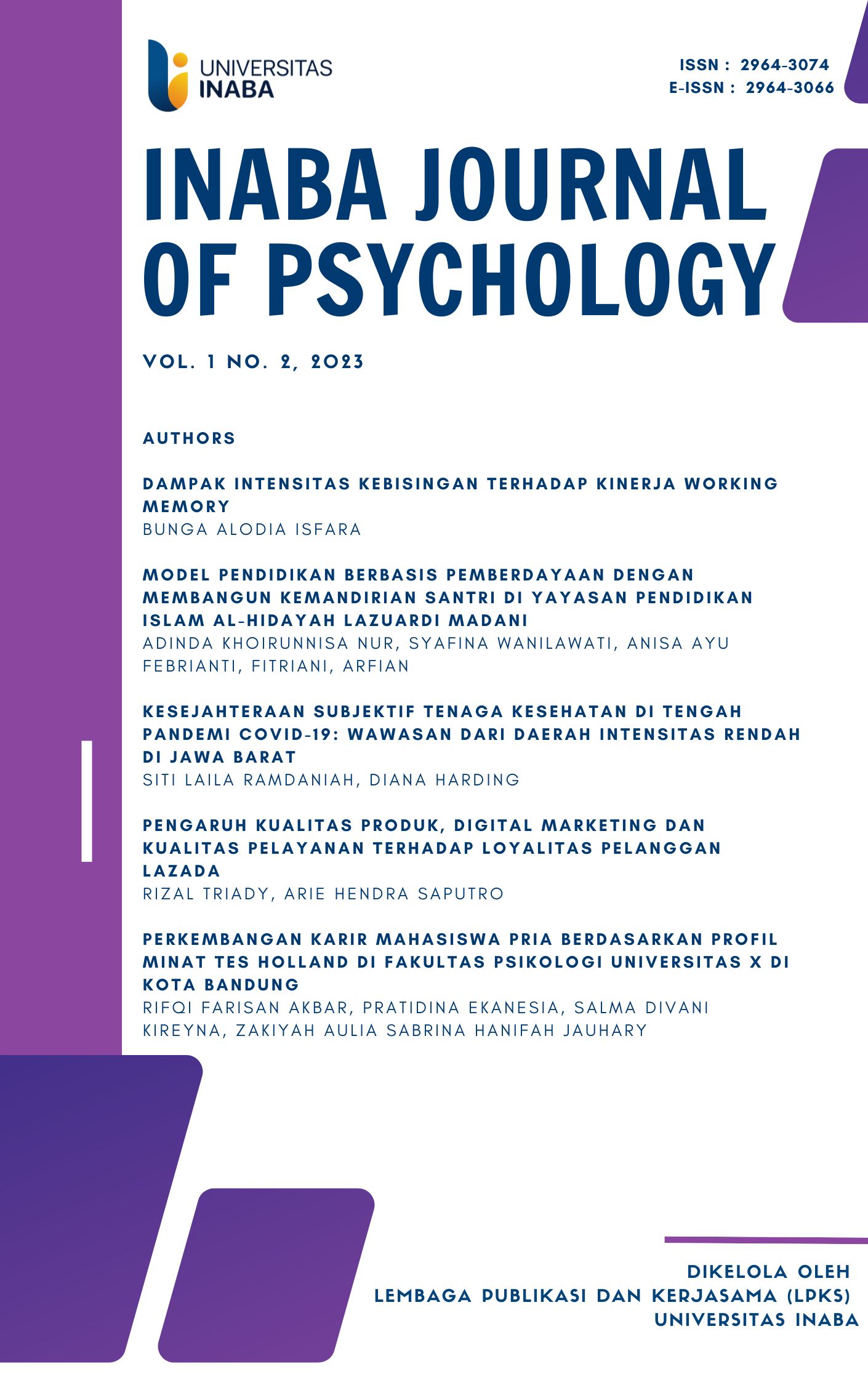Dampak Intensitas Kebisingan Terhadap Kinerja Working Memory
DOI:
https://doi.org/10.56956/ijop.v1i2.239Keywords:
kebisingan, working memory, eksperimenAbstract
Psikologi sebagai ilmu pengetahuan mempelajari perilaku manusia dan proses mental, dengan menekankan kemampuan sosial seperti komunikasi verbal, relasi interpersonal, dan pemahaman terhadap orang lain. Menurut teori John Holland, pria lebih cenderung berada pada tipe kepribadian Realistik, Investigatif, dan Enterprising, yang dicirikan oleh sifat agresif, kurang sosial, dan maskulin. Pada Fakultas Psikologi Universitas X di Bandung, jumlah mahasiswa laki-laki hanya sekitar 20% di setiap angkatan. Banyak dari mereka memilih fakultas ini karena akreditasi unggul. Namun, minat berperan penting dalam menentukan pilihan karier dan masih banyak mahasiswa pria yang bingung menentukan pekerjaan yang sesuai dengan minat mereka. Penelitian ini menggunakan metode deskriptif untuk menggambarkan status fenomena secara objektif. Hasil penelitian menunjukkan bahwa dari 30 mahasiswa yang diteliti, 14 orang memiliki kesesuaian antara minat karier berdasarkan tes Holland dengan pilihan karier pribadi mereka. Sementara itu, 16 mahasiswa lainnya belum menemukan kesesuaian antara minat dan bidang pekerjaan yang tepat. Temuan ini menunjukkan bahwa mahasiswa masih kurang menggali informasi tentang pilihan karier dan pemahaman terhadap minat pribadi. Lingkungan dan eksplorasi diri menjadi faktor penting dalam membantu mahasiswa mengidentifikasi karier yang sesuai dengan kepribadian dan minat mereka
References
Alloway, T. P. (2011). A comparison of working memory profiles in children with ADHD and DCD. Child Neuropsychology, 17(5), 483-494. https://doi.org/10.1080/09297049.2011.553590
Baddeley, A. (2003). Working memory: looking back and looking forward. Nature reviews neuroscience, 4(10), 829-839. https://doi.org/10.1038/nrn1201
Basner, M., Babisch, W., Davis, A., Brink, M., Clark, C., Janssen, S., & Stansfeld, S. (2014). Auditory and non- auditory effects of noise on health. The lancet, 383(9925), 1325-1332. https://doi.org/10.1016/S0140-6736(13)61613-X
Binyameen, M. M., Din, M. N. U., Khan, F. U., Khan, R., Ullah, S., & Hussain, M. (2022). Impact Of Working Memory On Students’ Learning Achievements In Mathematics At Secondary Level. Journal of Positive School Psychology, 6(7), 1814-1820.
Bostanov, V. (2003). Event-related brain potentials in emotion perception research, individual cognitive assessment and brain-computer interfaces (Doctoral dissertation, Universität Tübingen).
Choi, Y., Kim, M., & Chun, C. (2015). Measurement of occupants' stress based on electroencephalograms (EEG) in twelve combined environments. Building and Environment, 88, 65-72. https://doi.org/10.1016/j.buildenv.2014.10.003
Cresswell, J. W. (2010). Qualitative, Quantitatitve, and Mixed Methods Approaches. 3rd. Sage Publication.
Davies, D. R., & Jones, D. M. (1975). The effects of noise and incentives upon attention in short-term memory. British Journal of Psychology, 66(1), 61.
Fernandes, R. A., Vidor, D. C. G. M., & Oliveira, A. A. D. (2019, September). The effect of noise on attention and performance in reading and writing tasks. In CoDAS (Vol. 31, p. e20170241). Sociedade Brasileira de Fonoaudiologia. https://doi.org/10.1590/2317-1782/20182017241
Hidayati, N. (2007). Pengaruh Arus Lalu Lintas Terhadap Kebisingan (Studi Kasus Beberapa Zona Pendidikan Di Surakarta).
Higgins, S., Hall, E., Wall, K., Woolner, P., & McCaughey, C. (2005). The impact of school environments: A literature review. London: Design Council. Hockey, G. R. J. (1970). Effect of loud noise on attentional selectivity. Quarterly Journal of Experimental Psychology, 22(1), 28-36. https://doi.org/10.1080/14640747008401898
Hygge, S., & Knez, I. (2001). Effects of noise, heat and indoor lighting on cognitive performance and self- reported affect. Journal of environmental psychology, 21(3), 291-299. https://doi.org/10.1006/jevp.2001.0222
Jafari, M. J., Khosrowabadi, R., Khodakarim, S., & Mohammadian, F. (2019). The effect of noise exposure on cognitive performance and brain activity patterns. Open access Macedonian journal of medical sciences, 7(17), 2924. https://doi.org/10.3889/oamjms.2019.742
Jones, J. D. (2006). The effects of music training and selective attention on working memory during bimodal processing of auditory and visual stimuli. The Florida State University.
Ke, J., Du, J., & Luo, X. (2021). The effect of noise content and level on cognitive performance measured by electroencephalography (EEG). Automation in Construction, 130, 103836. https://doi.org/10.1016/j.autcon.2021.103836
Kennedy, M. M. (2006). Inside teaching: How classroom life undermines reform. Harvard University Press. Kormos, J., & Trebits, A. (2011). Working memory capacity and narrative task performance. In Second
Language Task Complexity (pp. 267-286). John Benjamins.
Langguth, B. (2011). A review of tinnitus symptoms beyond ‘ringing in the ears’: a call to action. Current medical research and opinion, 27(8), 1635-1643. https://doi.org/10.1185/03007995.2011.595781
Lu, Z. L., & Dosher, B. A. (2005). External noise distinguishes mechanisms of attention. In Neurobiology of attention (pp. 448-453). Academic Press. https://doi.org/10.1016/B978 012375731-9/50078-1
Lukey, B. J., & Tepe, V. (2008). Biobehavioral resilience to stress. Crc Press.
Pawlaczyk-Łuszczyńska, M., Dudarewicz, A., Waszkowska, M., Szymczak, W., & Śliwińska-Kowalska, M. (2005). The impact of low frequency noise on human mental performance. International Journal of Occupational Medicine & Environmental Health, 18(2).
Rahmawati, E. D. A. (2015). Dampak Intensitas Kebisingan terhadap Gangguan Pendengaran (Auditory Effect) pada Pekerja di Pabrik I PT Petrokimia Gresik.
Schlittmeier, S. J., Feil, A., Liebl, A., & Hellbrück, J. (2015). The impact of road traffic noise on cognitive performance in attention-based tasks depends on noise level even within moderate-level ranges. Noise & health, 17(76), 148. https://doi.org/10.4103/1463-1741.155845
Smith, A. P. (2012). An update on noise and performance: comment on Szalma and Hancock (2011). Psychological Bulletin, 138(6), 1262-1268. https://doi.org/10.1037/a0028867
Smith, G. W., & Classen, A. I. (2018). Experiencing a Reduction in Classroom Auditory Distractions for Students with and without Disabilities: A Phenomenological Inquiry. Journal of Ethnographic & Qualitative Research, 12(4).
Sörqvist, P. (2010). The role of working memory capacity in auditory distraction: A review. Noise and Health, 12(49), 217-224. https://doi.org/10.4103/1463-1741.70500
Sun, K., De Coensel, B., Sanchez, G. M. E., Van Renterghem, T., & Botteldooren, D. (2018). Effect of interaction between attention focusing capability and visual factors on road traffic noise annoyance. Applied Acoustics, 134, 16-24. https://doi.org/10.1016/j.apacoust.2018.01.001
Tak, S., Davis, R. R., & Calvert, G. M. (2009). Exposure to hazardous workplace noise and use of hearing protection devices among US workers—NHANES, 1999–2004. American journal of industrial medicine, 52(5), 358-371. https://doi.org/10.1002/ajim.20690
Wang, S., Yu, Y., Feng, Y., Zou, F., Zhang, X., Huang, J., & Liu, Y. (2016). Protective effect of the orientin on
noise-induced cognitive impairments in mice. Behavioural brain research, 296, 290-300. https://doi.org/10.1016/j.bbr.2015.09.024








